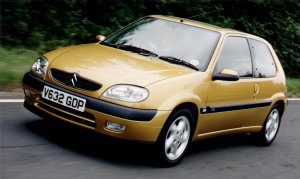The AX’s 1991 facelift also saw the Peugeot-badged sister car, the 106, released.
More ‘solid’ (and, of course, heavier) than the AX, it was perceived as a much less fragile car – so it was no surprise that the 1996 facelift to the 106 was accompanied by an almost identical Citroën sister – the Saxo.
Again, gaining weight – up from the 640kg of entry-spec pre-face lift AXs to 805kg for the lightest Saxos, to approaching a ton for the later performance VTS models – the Saxo traded a lot of the AXs delicacy and poise for solidity and a perception of quality.
Under the skin, the Saxo was little changed – the platform remained almost identical, and the TU engine range was carried over.
1997 saw a 1.6 TU engine appear in the VTR. Strangely, the 90bhp this put out was barely ahead of the AX GT of a decade before, despite 200cc more, and 10bhp behind the five-year-old AX GTi. This did not prevent it from reaching almost legendary status amongst small hot-hatches, however, and it has been a favourite of tuners and modifiers ever since.
Also released at the same time, the 16v head in the VTS put out a more respectable 120bhp, but was almost entirely uninsurable for the target market, leading to relatively poor sales. A 1.4 version of the Saxo was sold with the same body-kit styling as the VTR and VTS – badged on the continent as the VTL to emphasise the similarity, the UK saw it as the Furio, a badge also applied to similar “warm” versions of the ZX and later AXs.
1999 brought an instantly recognisable facelift for the Saxo, as well as a move to multiplexed electronics.
As the AX had heralded a change in approach for Citroën, compared to the predecessor Visa, so the 2002 launch of the C3 made the Saxo look very much a child of its time. The Saxo continued as an entry-level sister to the C3 for a year, until made redundant by the 2003 launch of the C2.



